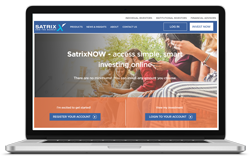Satrix, South Africa’s leading provider of index-tracking investment products and exchange-traded funds (ETFs) in South Africa, explains ETFs and how to choose and use them in your portfolio to grow your wealth.
The best day to start investing is today! Even with a small amount – it could even be as little as R10. The sooner you get going, the sooner your money will start working for you. A great place to begin your investment journey is by buying into an exchange traded fund – also known as an ETF. Selecting the right one can be simple – you just need to know what your goals are.
Siyabulela Nomoyi, Quantitative Portfolio Manager at Satrix, says that starting out as an investor can be daunting. “From taking out a bond to paying taxes, the first time you do anything money related feels a little overwhelming. Investing is the same. Those new to the investment scene often want a checklist to follow. They want credible information that spells out their options. One of the best ways to get a foot in the door is to invest in an ETF.”
Below, he shares how to start out investing in this easy, accessible investment product:
What Is An ETF And Why Should I Invest In One?
Simply put, an ETF is a basket of securities that tracks the performance of an underlying index (like the JSE Top 40 biggest listed companies, for example) or an asset, like gold. You then invest in a share of that basket by buying into the ETF from a stock exchange, in a similar way to trading shares. The big benefits of an ETF? You get instant diversification in your portfolio (a big win for any investor), plus, you generally pay lower fees.
How Do I Choose An ETF?
What’s your big investment goal?
- Are you planning to save for a holiday abroad?
- Or do you want to start your own business?
- Do you want to purchase your first home?
- Or save for your child’s education?
Some of these goals are more short term (a few months to a year). Some are more long term (10 to 20 years). The time factor really matters.
Know Your Timelines:
For short-term investing, lower-risk ETFs are worth considering. This means it’ll grow less aggressively and offer you a lower return, but you’ll be less impacted by any market movements. If you want to invest for the long term, higher risk ETFs are a better idea. They usually offer higher growth and, while the chance of setbacks is higher, your investment also has the best chance of recovering from any losses over time.
Think about a graph. If you zoom in, the lumps and bumps seem exaggerated. If you zoom out, the graph ‘smooths’ out to a flatter line. The same applies with your investments. In a shorter time period, market ‘moments’ hit you harder. Over a longer timeline, these tend to smooth out, and your investment recovers and grows from any downturns.
ETFs that track instruments like money market and bonds are good for a short-term investment. However, if you are looking to invest for more than a year or two, ETFs with local and international equities are better.
Diversify To Reduce Your Risk:
A way to reduce your chance of losing money (risk) is to consider investing in an ETF covering a wide range of stocks. This is called ‘spreading your risk’ – by spreading your money across multiple shares, you reduce the risk of losing lots of money should any single share not perform well.
In addition, having a mix of different ETFs in your portfolio helps reduce your total risk. A financial adviser can help you make the best selection to suit your investment goals. There are currently around 82 JSE-listed ETFs. About 50% of these are equity ETFs with local and international equities. (Equity refers to money that’s invested in a listed company through the purchasing of shares in that company). Your selection will depend on what you’re after. Ideally, you want a mix of local and international exposure. That means you’ll be exposed to different markets, which bolsters your resilience.
Understand the Costs Involved:
Generally, ETFs have lower fees than other options. But not all ETFs are equal when it comes to costs, even when tracking the same index. You need to know the Total Expense Ratio (TER) – that’s the total cost to manage and administer the fund. Different financial service providers offer ETFs that track the same index, so in comparing different TERs you can seek out the best value by selecting the one with the lower TER.
Which ETF Should I Invest In?
Now that you have some basics about ETF investing and starting your investment journey, the best way to move forward is to educate yourself on the types of ETFs that are on offer, understand your risk appetite and make sure that you understand your time horizon for your investment.
Satrix recognises that too much choice can sometimes be overwhelming, so we created the Satrix Access Range, which comprises four of our flagship funds, offering simplicity and ease of access and a great place to start exploring your first ETF(s). You can learn more about the Satrix Access Range here.
Conclusion
Starting your investing journey is exciting – it opens a whole new world of possibilities and builds a robust foundation for your future. The secret is to start sooner rather than later. You can invest a lot or a little. An ETF is the ideal vehicle to get a portfolio going.
Just start your investment journey today. Click here to learn more about our digital investment platform, SatrixNOW, where you can open an account for easy access to the full range of Satrix ETFs, unit trusts, as well as tax-free investments and retirement annuities
investments ad retirement annuities.
Disclaimer:
Satrix Investments (Pty) Ltd is an approved FSP in terms of the Financial Advisory and Intermediary Services Act (FAIS). The information does not constitute advice as contemplated in FAIS. Use or rely on this information at your own risk. Consult your Financial Adviser before making an investment decision.
While every effort has been made to ensure the reasonableness and accuracy of the information contained in this document (“the information”), the FSP, its shareholders, subsidiaries, clients, agents, officers and employees do not make any representations or warranties regarding the accuracy or suitability of the information and shall not be held responsible and disclaim all liability for any loss, liability and damage whatsoever suffered as a result of or which may be attributable, directly or indirectly, to any use of or reliance upon the information.


